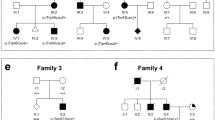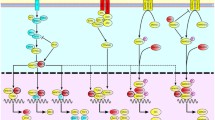Abstract
Tcm (total cataract with microphthalmia) is an autosomal dominant mouse eye mutation. Heterozygous Tcm/+ mice are born with several eye malformations including microphthalmia, retinal and iris dysplasia, total lens cataract, and ventral coloboma. The Tcm mutation was previously mapped to a 26-Mb region on Chr 4 between D4Mit235 and D4Mit106. In this study, we characterize the Tcm/Tcm homozygous mutant and find they are viable but severely microphthalmic. The developing eye in the Tcm/Tcm homozygote shows defects during early eye development, before formation of the optic cup. Further genetic mapping reduced the Tcm critical region to a 1.3-Mb region bordered by SNPs rs3666764 and rs3713818. This critical region contains two known genes (Asph and Gfd6) and three predicted genes, all of which are positional candidates for Tcm. Sequence analysis of Tcm genomic DNA revealed no mutations in the coding regions and splice site junctions of the five candidate genes. These results indicate that the causitive Tcm mutation falls within a noncoding regulatory region of one of the five candidate genes or in an undescribed gene.




Similar content being viewed by others
References
Altschul SF, Gish W, Miller W, Myers EW, Lipman DJ (1990). Basic local alignment search tool. J Mol Biol 215: 403–410
Anchan RM, Reh TA, Angello J, Balliet A, Walker M (1991) EGF and TGF-alpha stimulate retinal neuroepithelial cell proliferation in vitro. Neuron 6: 923–936
Burmeister M, Novak J, Liang MY, Basu S, Ploder L, et al. (1996) Ocular retardation mouse caused by Chx10 homeobox null allele: impaired retinal progenitor proliferation and bipolar cell differentiation. Nat Genet 12: 376–384
Burstedt MS, Forsman–Semb K, Golovleva I, Janunger T, Wachtmeister L, et al. (2001) Ocular phenotype of bothnia dystrophy, an autosomal recessive retinitis pigmentosa associated with an R234 W mutation in the RLBP1 gene. Arch Ophthalmol 119: 260–267
Chang C, Hemmati–Brivanlou A (1999) Xenopus GDF6, a new antagonist of noggin and a partner of BMPs. Development 126: 3347–3357
Daniel A, Dumstrei K, Lengyel JA, Hartenstein V (1999) The control of cell fate in the embryonic visual system by atonal, tailless and EGFR signaling. Development 126: 2945–2954
Dinchuk JE, Henderson NL, Burn TC, Huber R, Ho SP, et al. (2000) Aspartyl beta-hydroxylase (Asph) and an evolutionarily conserved isoform of Asph missing the catalytic domain share exons with junctin. J Biol Chem 275: 39543–39554
Dinchuk JE, Focht RJ, Kelley JA, Henderson NL, Zolotarjova NI et al. (2002) Absence of post-translational aspartyl beta-hydroxylation of epidermal growth factor domains in mice leads to developmental defects and an increased incidence of intestinal neoplasia. J Biol Chem 277: 12970–12977
Fantes J, Ragge NK, Lynch SA, McGill NI, Collin JR, (2003) Mutations in SOX2 cause anophthahnia. Nat Genet 33: 461–463
Glaser T, Jepeal L, Edwards JG, Young SR, Favor J et al. (1994) PAX6 gene dosage effect in a family with congenital cataracts, aniridia, anophthalmia and central nervous system defects. Nat Genet 7: 463–471
Goudreau G, Petrou P, Reneker LW, Graw J, Loster J, et al. (2002) Mutually regulated expression of Pax6 and Six3 and its implications for the Pax6 haploinsufficient lens phenotype. Proc Natl Acad Sci USA 99: 8719–8724
Graw J, Favor J, Neuhauser–Klaus A, Ehling UH (1986) Dominant cataract and recessive specific locus mutations in offspring of X-irradiated male mice. Mutat Res 159: 47–54
Hallsson JH, Favor J, Hodgkinson C, Glaser T, Lamoreux ML, et al. (2000) Genomic, transcriptional and mutational analysis of the mouse microphthalmia locus. Genetics 155: 291–300
Hill RE, Favor J, Hogan BL, Ton CC, Saunders GF, et al. (1991) Mouse small eye results from mutations in a paired-like homeobox-containing gene. Nature 354: 522–525
Intres R, Goldflam S, Cook JR, Crabb JW (1994) Molecular cloning and structural analysis of the human gene encoding cellular retinaldehyde-binding protein. J Biol Chem 269: 25411–25418
Kaufman MH (1992) The atlas of mouse development (London, San Diego: Academic Press)
Manly KF, Cudmore RH, Jr, Meer JM (2001) Map Manager QTX, cross-platform software for genetic mapping. Mamm Genome 12: 930–932
Marsh–Armstrong N, McCaffery P, Gilbert W, Dowling JE, Drager UC (1994) Retinoic acid is necessary for development of the ventral retina in zebrafish. Proc Natl Acad Sci USA 91: 7286–7290
Martinez–Morales JR, Signore M, Acampora D, Simeone A, Bovolenta P (2001) Otx genes are required for tissue specification in the developing eye. Development 128: 2019–2030
Mathers PH, Grinberg A, Mahon KA, Jamrich M (1997) The Rx homeobox gene is essential for vertebrate eye development. Nature 387: 603–607
Matsuo I, Kuratani S, Kimura C, Takeda N, Aizawa S (1995) Mouse Otx2 functions in the formation and patterning of rostral head. Genes Dev 9: 2646–2658
Maw MA, Kennedy B, Knight A, Bridges R, Roth KE, (1997) Mutation of the gene encoding cellular retinaldehyde-binding protein in autosomal recessive retinitis pignientosa. Nat Genet 17: 198–200
McCaffery P, Lee MO, Wagner MA, Sladek NE, Drager UC (1992) Asymmetrical retinoic acid synthesis in the dorsoventral axis of the retina. Development 115: 371–382
McCaffery P, Posch KC, Napoli JL, Gudas L, Drager UC (1993) Changing patterns of the retinoic acid system in the developing retina. Dev Biol 158: 390–399
Morimura H, Berson EL, Dryja TP (1999) Recessive mutations in the RLBP1 gene encoding cellular retinaldehyde-binding protein in a form of retinitis punctata albescens. Invest Ophthalmol Vis Sci 40: 1000–1004
Morotome Y, Goseki–Sone M, Ishikawa I, Oida S (1998) Gene expression of growth and differentiation factors-5, -6, and -7 in developing bovine tooth at the root forming stage. Biochem Biophys Res Commun 244: 85–90
Panagabko C, Morley S, Hernandez M, Cassolato P, Gordon H, et al. (2003) Ligand specificity in the CRAL-TRIO protein family. Biochemistry 42: 6467–6474
Percin EF, Ploder LA, Yu JJ, Arici K, Horsford DJ, et al. (2000) Human microphthahnia associated with mutations in the retinal homeobox gene CHX10. Nat Genet As, 25:397–401
Porter FD, Drago J, Xu Y, Cheema SS, Wassif C, et al. (1997) Lhx2, a LIM homeobox gene, is required for eye, forebrain, and definitive erythrocyte development. Development 124: 2935–2944
Rissi M, Wittbrodt J, Delot E, Naegeli M, Rosa FM, (1995) Zebrafish Radar: a new member of the TGF-beta superfamily defines dorsal regions of the neural plate and the embryonic retina. Mech Dev 49: 223–234
Rossant J, Tam PPL (2002) Mouse development: patterning, morphogenesis, and organogenesis (San Diego, CA: Academic Press)
Saari JC, Nawrot M, Kennedy BN, Garwin GG, Hurley JB, et al. (2001) Visual cycle impairment in cellular retinaldehyde binding protein (CRALBP) knockout mice results in delayed dark adaptation. Neuron 29: 739–748
Schimmenti LA, de la Cruz J, Lewis RA, Karkera JD, Manligas GS, et al. (2003) Novel mutation in sonic hedgehog in non-syndromic colobomatous microphthalmia. Am J Med Genet 116A, 215–221
Settle SH, Jr, Rountree RB, Sinha A, Thacker A, Higgins K, et al. (2003) Multiple joint and skeletal patterning defects caused by single and double mutations in the mouse Gdf6 and Gdf5 genes. Dev Biol 254: 116–130
Storm EE, Huynh TV, Copeland NG, Jenkins NA, Kingsley DM, et al. (1994) Limb alterations in brachypodism mice due to mutations in a new member of the TGF beta-superfamily. Nature 368: 639–643
Takebayashi K, Chida K, Tsukamoto I, Morii E, Munakata H, et al. (1996) The recessive phenotype displayed by a dominant negative microphthalmia-associated transcription factor mutant is a result of impaired nucleation potential. Mol Cell Biol 16: 1203–1211
Thompson PM, Gotoh T, Kok M, White PS, Brodeur GM (2003) CHD5, a new member of the chromodomain gene family, is preferentially expressed in the nervous system. Oncogene 22: 1002–1011
van Heyningen V, Williamson KA (2002) PAX6 in sensory development. Hum Mol Genet 11: 1161–1167
van Raamsdonk CD, Tilghman SM (2000) Dosage requirement and allelic expression of PAX6 during lens placode formation. Development 127: 5439–15448
Vincent MC, Pujo AL, Olivier D, Calvas P (2003) Screening for PAX6 gene mutations is consistent with haploinsufficiency as the main mechanism leading to various ocular defects. Eur J Hum Genet 11: 163–169
Vissers LE, van Ravenswaaij CM, Admiraal R, Hurst JA, de Vries BB, et al. (2004) Mutations in a new member of the chromodomain gene family cause CHARGE syndrome. Nat Genet 36: 955–957
Voronina VA, Kozhemyakina EA, O’Kernick CM, Kahn ND, Wenger SL et al. (2004) Mutations in the human RAX homeobox gene in a patient with anophthalmia and sclerocornea. Hum Mol Genet 13: 315–322
Woodage T, Basrai MA, Baxevanis AD, Hieter P, Collins FS (1997) Characterization of the CHD family of proteins. Proc Natl Acad Sci USA 94: 11472–11477
Zhou E, Grimes P, Favor J, Koeberlein B, Pretsch W, et al. (1997) Genetic mapping of a mouse ocular malformation locus, Tcm, to chromosome 4. Mamm Genome 8: 178–181
Acknowledgments
The authors wish to thank the late Patricia A. Grimes (Department of Ophthalmology, University of Pennsylvania) for her expertise and assistance in the analysis and interpretation of the Tcm histopathology. This research was supported in part by funding from the NIH Medical Scientist Training Program.
Author information
Authors and Affiliations
Corresponding author
Rights and permissions
About this article
Cite this article
Wang, K.S., Zahn, L.E., Favor, J. et al. Genetic and phenotypic analysis of Tcm, a mutation affecting early eye development. Mamm Genome 16, 332–343 (2005). https://doi.org/10.1007/s00335-004-2444-7
Received:
Accepted:
Issue Date:
DOI: https://doi.org/10.1007/s00335-004-2444-7




